
When a crime is committed, only the victim and the victim's close
When a crime is committed, only the victim and the victim's close circle experience the event as pain, terror, death. To people hearing or reading about it, crime is a metaphor, a symbol of the ancient battles fought every day: evil versus good, chaos versus order.






In the profound and unsettling words of S. J. Rozan, “When a crime is committed, only the victim and the victim’s close circle experience the event as pain, terror, death. To people hearing or reading about it, crime is a metaphor, a symbol of the ancient battles fought every day: evil versus good, chaos versus order,” we find a truth that pierces through the illusion of distance. These words unveil the double face of violence and perception—how suffering is lived as agony by the few and interpreted as symbol by the many. Rozan, a master of crime fiction, speaks not only of the stories she writes but of the deeper nature of human empathy and imagination: that tragedy, when witnessed from afar, transforms from wound into parable, from the real into the representative.
The meaning of this quote rests in the separation between experience and understanding. For those who suffer directly—the victim, the grieving family, the circle of love surrounding them—crime is not concept but calamity, not allegory but abyss. It is lived in the flesh, in the pulse, in the sleepless nights and the hollow ache that follows. But for those who merely hear or read of it, the pain becomes something else—an echo transformed by distance into symbol. We interpret it, categorize it, even moralize it, as though the chaos of blood and grief could be understood through story. In doing so, we reveal both the strength and the limitation of the human mind: its need to turn horror into meaning, to impose order upon the unendurable.
Rozan’s insight touches upon one of the oldest instincts of humankind—our drive to make sense of suffering by casting it into myth. The ancients did this in their epics and tragedies. The murder of Agamemnon was not simply the act of a wife’s vengeance; it became the eternal warning of pride and betrayal. The slaying of Abel by Cain was not just a brother’s crime—it became the first and greatest parable of envy and human fallenness. Even in modern times, when we read of crimes in the news or watch them unfold in fiction, we participate in this same ancient ritual. We turn the pain of others into mirrors, reflecting our fears, our moral codes, and our struggle to see meaning in a world where cruelty often seems senseless.
But Rozan’s words also hold a warning. When we transform real suffering into metaphor, we risk forgetting that behind every story lies a beating heart that once knew terror. The philosopher Hannah Arendt, writing of the Holocaust, warned that when evil becomes merely a concept, it is robbed of its true horror. It becomes easy to speak of “good and evil” in the abstract, while forgetting the trembling hands of the dying, the tears of the living. Rozan’s quote reminds us that to truly understand the weight of crime—or any act of evil—we must remember its human face. To the reader, a murder is a symbol of chaos. To the widow, it is an unending silence.
Consider the story of Kitty Genovese, the young woman murdered in New York in 1964. The story became a symbol of societal indifference when reports claimed dozens of witnesses ignored her cries for help. The public saw it as a metaphor—a lesson about apathy, a mirror held up to the decay of urban morality. Yet, for her family, her friends, and the few who truly tried to save her, it was not a symbol. It was personal devastation, a raw wound that never closed. The world took her tragedy and turned it into a moral fable, but for those who loved her, it remained what it had always been: unbearable loss. Thus, Rozan’s wisdom lives in this contrast—the way distance turns grief into idea, and how easily we forget the human cost behind the symbol.
And yet, there is also compassion hidden in Rozan’s reflection. To make meaning out of suffering—to see in it a struggle between chaos and order, good and evil—is part of what allows humanity to continue. Without this instinct to symbolize, to turn pain into story, the world’s cruelty would overwhelm us. Through metaphor, we learn; through symbol, we make sense of senselessness. The danger lies not in this transformation itself, but in forgetting that meaning is built upon the bones of reality. The wise heart learns to hold both truths at once—to see the symbol without losing sight of the sorrow.
So, dear listener, the lesson is this: when you encounter the suffering of others—whether in life, history, or story—remember that what is metaphor to you was life and death to someone else. Let empathy accompany understanding. When you read of crime, or tragedy, or injustice, do not let it become merely a fable in your mind. Pause, honor the pain that gave rise to the lesson. To live wisely is to see not only the eternal battle of good and evil, but also the small and fragile humans who fight within it.
For as S. J. Rozan teaches us, the stories we tell of evil and order are not born from myth—they are born from the cries of real people. And if we listen closely, behind the symbols and metaphors, we can still hear those cries—reminding us that compassion, not abstraction, is the truest victory of good over chaos.






AAdministratorAdministrator
Welcome, honored guests. Please leave a comment, we will respond soon